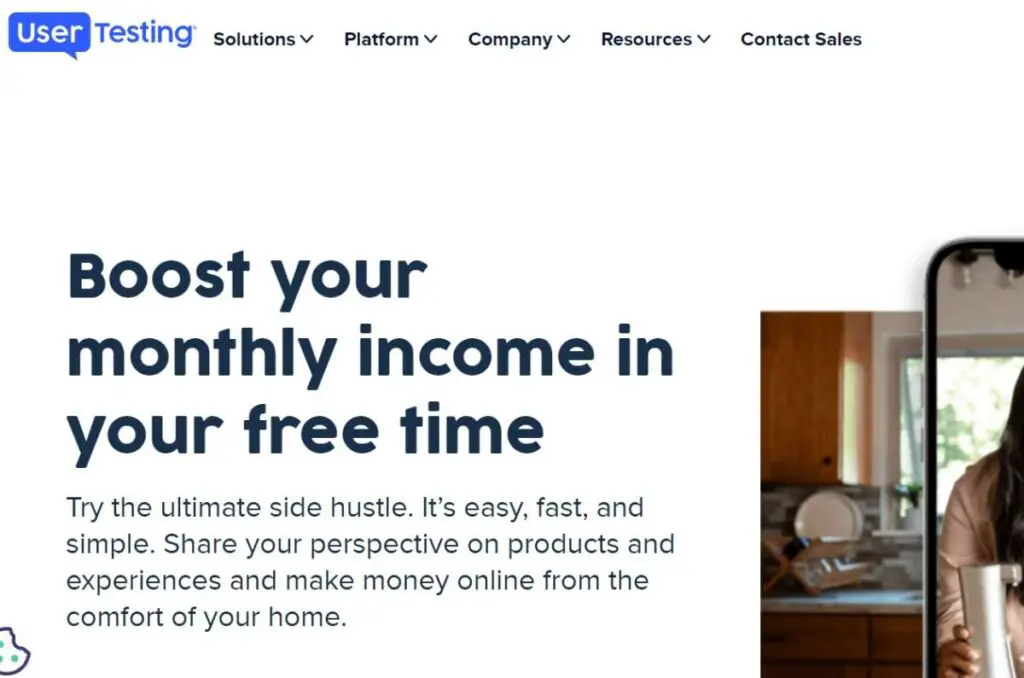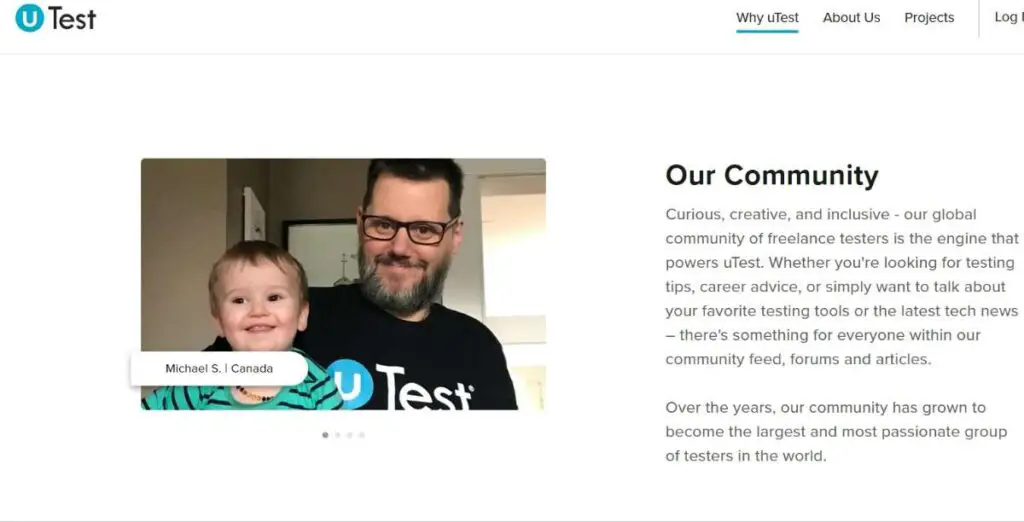Are you tired of the same old 9-5 grind? Do you want to make extra cash in your free time? If you’re a tech-savvy individual with an eye for detail, then website testing might just be the perfect side hustle for you. You could get paid to test websites.
In this blog post, I’ll explore the world of website testing and show you how you can get paid to test websites from the comfort of your own home.
From the skills you need to the best platforms to sign up for, we’ll cover everything you need to know to get started and earn some extra income.
So, let’s dive in and discover how you can turn your passion for the internet into a profitable gig!
- Getting Started with Website Testing
- How to Become a Website Tester and Get Paid for It
- Top Platforms to Get Paid to Test Websites
- Getting Paid for Website Testing
- The Process of Testing Websites and getting paid
- Challenges in Website Testing
- Testing Websites vs Apps
- Last Thoughts
- Frequently Asked Questions
- How much can I earn testing websites and apps?
- What are some legitimate websites that pay for testing?
- What are some tips for improving my user testing skills?
- Are there any user testing jobs for beginners?
- What are some common mistakes to avoid when testing websites?
- What are the requirements to become an online tester?
Getting Started with Website Testing
If you’re interested in making some extra cash by testing websites, you’ve come to the right place.
I’ll walk you through the basic requirements, the equipment you’ll need and how to qualify for testing so you can get paid to test websites.
Basic Requirements
To get started with website testing, you’ll need a few things. First, you’ll need a reliable internet connection. This is essential since you’ll be testing websites online. Just like if you were to get paid to test AI.
You’ll also need a computer or mobile device that meets the minimum requirements for the testing platform you choose.
Most website testing platforms require you to be at least 18 years old to participate.
Additionally, some platforms may require you to have a webcam and microphone to record your testing sessions.
Getting the Right Equipment
To ensure that you’re able to get paid to test websites efficiently, it’s important to have the right equipment. If you’re using a computer, make sure it meets the minimum requirements for the testing platform you choose.
This usually includes having an up-to-date operating system and browser.
If you’re using a mobile device, make sure it’s compatible with the testing platform you choose.
Some platforms may require you to have an Android phone, iPhone, or iPad.
Qualifying for Testing
Once you have the basic requirements and equipment in place, you’ll need to qualify for testing websites.
Most website testing platforms require you to take a qualification test to ensure that you’re able to provide useful feedback and you are the right candidate to get paid to test websites.
During the qualification test, you’ll be asked to complete a set of tasks while recording your screen and speaking your thoughts out loud.
This is to ensure that you’re able to provide detailed feedback on the website or app you’re testing.
If you pass the qualification test, you’ll be able to start testing websites and earning money.
Keep in mind that some platforms may require you to complete a certain number of tests before you’re eligible for payment.
How to Become a Website Tester and Get Paid for It
Getting paid to test websites is a fairly straightforward process. Here’s what you need to do to get started:
Signing Up for Testing Platforms
The first step is to sign up for one or more testing platforms. There are many websites that pay people to test websites, apps, and other digital products.
Some popular options include UserTesting, TryMyUI, and TestingTime. You can find a comprehensive list of companies that pay you to test websites here.
To sign up, you’ll typically need to provide some basic information about yourself, such as your name, email address, and demographic information.
You may also need to complete a qualification test to ensure that you meet the company’s requirements for testers.
Taking Practice Tests
Once you’re signed up, you’ll likely have the opportunity to take practice tests. These are tests that simulate the actual testing experience, but they don’t pay you.
They’re designed to help you get familiar with the testing process and to ensure that you’re comfortable with the platform.
Taking practice tests is a great way to improve your skills and increase your chances of getting paid testing opportunities.
Make sure to take your time and provide detailed feedback on each task.
This will help you stand out as a professional tester and increase your chances of getting paid testing opportunities in the future.
Top Platforms to Get Paid to Test Websites
Getting paid to test websites has never been easier. You can earn some extra cash on plenty of platforms available that will pay you for your time and feedback.
Here are some of the top platforms you can use to get paid for testing websites.
1. UserTesting

UserTesting is one of the most popular platforms for website testing. It’s easy to sign up and start testing websites right away.
You’ll typically earn $10 for a 20-minute test, and you can earn more for longer tests. UserTesting pays via PayPal.
If you like this platform and would like to discover more sites like this one, this blog post covers an entire list of websites like Usertesting.
2. UserFeel
UserFeel is another great platform for website testing. You’ll typically earn $10 for a 10-20 minute test, and you can earn more for longer tests. UserFeel pays via PayPal.
3. TryMyUI
Get paid to test websites with TryMyUI, a platform that pays you to test websites and mobile apps.
You’ll typically earn $10 for a 20-minute test, and you can earn more for longer tests. TryMyUI pays via PayPal.
4. UserBrain
Another popular platform to test sites and earn is UserBrain. Just sign in and follow their prompts to the testing process.
You’ll typically earn $3 for a 5-15 minute test, and you can earn more for longer tests.
UserBrain pays via PayPal.
5. uTest

Getting paid to test sites is easy with uTest. This platform is a leader in the field. You can test websites, mobile apps, and software and make money.
You’ll typically earn $5-$10 per bug you find, and you can earn more for more complex bugs.
uTest pays via PayPal.
6. Loop11
You won’t be short of options to test websites and earn cash. Loop11 is a platform that pays you to do so.
You’ll typically earn $5-$10 per test, and you can earn more for more complex tests.
Cash out your Loop11 money via PayPal.
7. UserZoom
UserZoom will pay you between $5-$10 per test, and you can earn more for more complex tests.
You’ll need PayPal to cash out your earnings
8. Validately
Another great option to get paid to test sites is Validately. They have also an app you can use.
You can expect to earn between $5 to $10 per test or even more for complex tests.
Get your Paypal account ready to receive your cash out.
9.TestBirds
One of the most popular sites that pay you to test websites is TestBirds. As it is the industry standard, you’ll earn $10 to $20 per test. TestBirds is a legit site that pays via PayPal.
10. Respondent
Respondent is a platform that pays you to participate in research studies, including website testing. You can earn up to $140 per study. Respondent pays via PayPal.
11. Ferpection
Ferpection is a platform that pays you to test websites and mobile apps. You’ll typically earn $10 per test, and you can earn more for more complex tests. Ferpection pays via PayPal.
12. UserCrowd

UserCrowd is a platform that pays you to participate in user testing and surveys. You’ll typically earn $0.20-$0.50 per task. UserCrowd pays via PayPal.
13. StartUpLift
StartUpLift is a platform that pays you to test websites and provide feedback to startups. You’ll typically earn $5 per test. StartUpLift pays via PayPal.
14. Beta Testing
Beta Testing is a platform that pays you to test websites, mobile apps, and software. You’ll earn between $10 to $20 per test. Receive your earnings on PayPal.
15. Amazon Mechanical Turk
Amazon Mechanical Turk is a platform that pays you to complete small tasks, including website testing. The competition can be huge.
It doesn’t pay too much. You’ll make $0.01-$0.10 per task. However, you would want to have it in your portfolio. Amazon Mechanical Turk pays via Amazon gift cards or direct deposit.
16. MyCrowd
MyCrowd is a platform that pays you to test websites and mobile apps.
It is not one of the best paying since you’ll typically earn $0.50-$1 per test. But it is worth exploring. They pay via PayPal.
17. Test IO
Test IO is a platform that pays you to test websites, mobile apps, and software. Additionally, it is one of the highest-paying testing sites.
You’ll typically earn $5-$50 per bug you find. However, the trick is to find enough bugs to make a decent income from it.
18. Tester Work
Another that presents a high-income potential is Tester Work. This platform pays you to test websites, mobile apps, and software.
Earn $10-$50 per test or more for more complex tests. Tester Work pays via PayPal.
19. Upwork
Upwork is a platform that connects freelancers with clients who need website testing services. You can set your own rates and earn as much as you want. Upwork pays via PayPal.
20. Fiverr
Fiverr is a platform that connects freelancers with clients who need website testing. This is a great chance fo you to set your own earning rates and make more money as you gain more experience testing websites.
Getting Paid for Website Testing
As a website tester, you can earn money by providing your feedback on websites.
But how do you get paid for your work? Here are some common payment methods and earning potentials to keep in mind.
Payment Methods
Most website testing companies offer payment via PayPal, which is a quick and easy way to receive your earnings.
Some companies also offer other payment methods, such as gift cards or direct deposit.
Make sure to check the payment options before signing up for a website testing company, so you know how you will receive your compensation.
Earning Potential
The amount of money you can earn by testing websites varies depending on the company and the type of test.
Some companies pay $10-$15 for a 20-minute test, while others pay more for longer tests or more in-depth feedback.
You can earn extra income by signing up for multiple website testing companies and completing tests regularly.
Note that website testing should not be seen as a full-time job or a way to get rich quickly.
However, it can be a fun and easy way to earn some extra cash in your free time.
Plus, you get to provide valuable feedback to help improve websites and user experiences.
The Process of Testing Websites and getting paid
As a website tester, your job is to perform different tasks on a website and provide feedback to the company. The process of testing websites usually involves performing tasks, giving feedback, and reporting bugs.
Performing Tasks
When you receive a task, they’ll ask you to perform a specific action on the website.
For example, if they could tell you to navigate to a specific page, sign up for a newsletter, or make a purchase.
As you perform the task, you should pay attention to the website’s user-friendliness, ease of navigation, and overall design.
Take note of any thoughts or impressions that come to mind as you complete the task. You’ll have to report on those.
Giving Feedback
After completing the task, you’ll have to provide feedback on your experience. This feedback is crucial for the company to improve its website’s user experience.
Your feedback should be honest, constructive, and specific. If you encountered any issues or difficulties during the task, be sure to mention them in your feedback.
Additionally, if you have any suggestions for improvement, feel free to include them as well.
Reporting Bugs
If you encounter any bugs or technical issues during the task, you should report them immediately.
Bugs can include broken links, error messages, or any other technical issues that prevent you from completing the task.
When reporting bugs, be sure to provide as much detail as possible, including the steps you took to encounter the bug and any error messages you received.
Challenges in Website Testing
As with any job, testing websites comes with its own set of challenges. Let’s discuss two of the most common challenges that testers face: finding test opportunities and maintaining quality.
Finding Test Opportunities
One of the biggest challenges in website testing is finding test opportunities. While there are plenty of websites out there that pay testers to provide feedback, not all of them have a steady stream of work available.
This means that you may need to sign up for multiple websites in order to find consistent work.
To make the process of finding test opportunities easier, consider signing up for a few different websites that offer paid testing opportunities.
Keep an eye out for new testing opportunities as they become available, and be sure to apply for them as soon as possible.
Maintaining Quality
Another challenge that testers face is maintaining quality. When you’re testing websites, it’s important to provide accurate and detailed feedback that will help the website owner improve their site.
However, it can be difficult to maintain this level of quality over time, especially if you’re testing multiple websites at once.
To maintain quality, try to focus on one website at a time. This will allow you to give each website your full attention and provide more detailed feedback.
Additionally, be sure to take breaks between testing sessions to avoid burnout and maintain your focus.
Testing Websites vs Apps
When it comes to testing digital products, there are two main types of testing: website testing and app testing.
While both types of testing involve evaluating the functionality of a product, there are some key differences between the two.
Website Testing
Website testing involves evaluating the functionality of a website. As a website tester, you will be tasked with testing the usability, accessibility, and functionality of a website.
This may involve testing links, buttons, forms, and other interactive elements on the site.
One of the benefits of website testing is that it can be done on any device with an internet connection. This means that you can test websites on your desktop computer, laptop, tablet, or smartphone.
Additionally, website testing is often more straightforward than app testing, as websites tend to have simpler functionality.
App Testing
App testing involves evaluating the functionality of an app. As an app tester, you will be tasked with testing the usability, accessibility, and functionality of an app.
This may involve testing buttons, forms, and other interactive elements within the app.
One of the benefits of app testing is that it allows you to test the functionality of an app on a specific platform, such as iOS or Android.
This is important because different platforms may have different functionality or user interfaces. Additionally, app testing may involve testing more complex functionality than website testing, such as in-app purchases or push notifications.
Last Thoughts
Congratulations! You’ve made it to the end of this article about getting paid to test websites.
By now, you should have a good idea of what website testing involves, how to get started, and where to find paid opportunities.
Remember, website testing can be a fun and flexible way to earn extra cash. It’s also a great way to improve your own user experience skills and contribute to the development of new products and services.
If you’re serious about pursuing website testing as a side hustle or even a full-time job, here are a few key takeaways to keep in mind:
- Be patient and persistent. It may take some time to find the right opportunities and build up a reputation as a reliable tester.
- Stay organized. Keep track of your testing assignments, deadlines, and payments to ensure that you’re meeting your obligations and getting paid on time.
- Always be professional. Treat each testing assignment as a serious job and communicate clearly and respectfully with clients and fellow testers.
- Keep learning. Stay up-to-date with the latest trends and best practices in website testing and user experience research to improve your skills and stay competitive in the industry.
We hope this article has been helpful in getting you started on your website testing journey. Good luck!
Read next: How to Start Freelancing on machine learning
Frequently Asked Questions
How much can I earn testing websites and apps?
The amount you can earn testing websites and apps varies depending on the company and the length of the test. Some companies pay a flat rate per test, while others pay based on the length of the test. On average, you can expect to earn between $5 and $60 per test. Some companies also offer bonuses for completing a certain number of tests or for providing high-quality feedback.
What are some legitimate websites that pay for testing?
There are many legitimate websites that pay for testing, including UserTesting, Userfeel, TryMyUI, and TestingTime. It’s important to do your research and make sure the website is reputable before signing up. Look for reviews from other testers and check the website’s payment policies.
What are some tips for improving my user testing skills?
To improve your user testing skills, it’s important to be thorough and detailed in your feedback. Take the time to carefully read the instructions and complete all the tasks. Speak your thoughts out loud as you complete the test, and be sure to provide specific feedback on what you liked and didn’t like about the website or app. It’s also helpful to practice and take feedback from other testers.
Are there any user testing jobs for beginners?
Yes, there are user testing jobs available for beginners. Some companies specifically target beginners, while others offer training and support to help you get started. It’s important to be patient and persistent and to take the time to learn the skills you need to be a successful tester.
What are some common mistakes to avoid when testing websites?
Some common mistakes to avoid when testing websites include rushing through the test, not following the instructions, and providing vague or unhelpful feedback. It’s important to take your time and carefully read the instructions and to provide specific and detailed feedback on your experience. Avoid making assumptions about the website or app, and be sure to test all the features and functions.
What are the requirements to become an online tester?
To become an online tester, you typically need a computer or mobile device with an internet connection, a microphone, and the ability to record your screen. Some companies also require you to have a webcam. You should also have good communication skills and be able to provide detailed feedback. Some companies may also require you to take a test to prove your skills before you can start testing.


